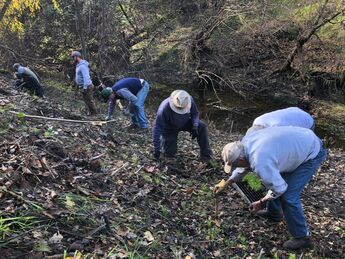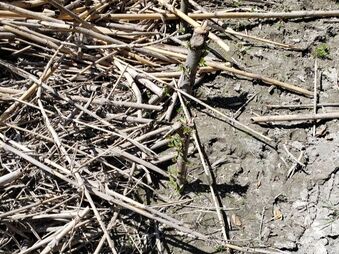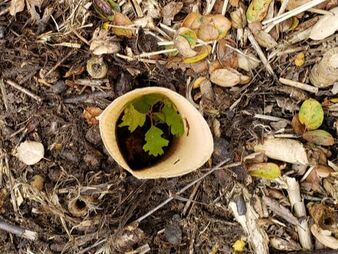 Planting plugs of creeping wild rye
Planting plugs of creeping wild rye
After removing the Arundo plants, property owners will want to consider whether and how to replant the area. Typically, the site will look pretty barren after it has been cleared of Arundo because Arundo tends to displace other plants. Waiting one full year before replanting is a helpful practice because it provides time for follow-up herbicide treatments to kill the Arundo rhizomes. Planting sooner puts new plants at risk of being inadvertently killed by herbicide treatments intended for Arundo only.
There are various motivations for replanting a cleared site and therefore a number of different replanting strategies. In some cases, the property owner may be concerned about creek bank stability and will opt to replace the Arundo with other plants that can stabilize the bank. In other cases, property owners may want to replace the Arundo with native plants in order to restore the site to a more native environment. And in other cases, the property owner may just prefer not to look at a patch of empty dirt and would rather see it planted for purely aesthetic reasons. Sometimes, property owners may be motivated by both environmental and aesthetic considerations and opt to plant pollinator gardens or other types of wildlife-friendly habitat.
Planting Zones
There are four planting zones: the creek bed, the bank (two zones), and the top of the bank. Planting strategy needs to vary depending on the zone.
There are various motivations for replanting a cleared site and therefore a number of different replanting strategies. In some cases, the property owner may be concerned about creek bank stability and will opt to replace the Arundo with other plants that can stabilize the bank. In other cases, property owners may want to replace the Arundo with native plants in order to restore the site to a more native environment. And in other cases, the property owner may just prefer not to look at a patch of empty dirt and would rather see it planted for purely aesthetic reasons. Sometimes, property owners may be motivated by both environmental and aesthetic considerations and opt to plant pollinator gardens or other types of wildlife-friendly habitat.
Planting Zones
There are four planting zones: the creek bed, the bank (two zones), and the top of the bank. Planting strategy needs to vary depending on the zone.
- You will probably plant nothing in the creek bed (the water itself) although you may have some tree trunks growing out of it or add the occasional willow or alder tree.
- The lower bank should have mainly plants with long, strong roots for bank stabilization.
- The upper bank should have grasses, flowers, and/or ground covers suitable for a riparian environment, that is, plants that are happy with a good deal of shade and more moisture in the soil.
- The top of the bank should have the same plants as the upper bank, blending to whatever plants are in the surrounding habitat at the outer edge of the riparian influence.
- Trees and shrubs can go anywhere in the upper three zones according to their water tolerance
 Willow stakes sprouting
Willow stakes sprouting
Planting for Bank Stabilization
In the past, Arundo was thought to serve a stabilizing role on steep creek banks. Over time, Arundo’s value as a bank stabilizer has become questionable because its roots are shallow and can slough off a steep bank. Also, Arundo can invade a creek so thoroughly and can become so dense that it actually changes the water flow, which can cause severe erosion.
Trees and shrubs can be planted in the bare ground around the Arundo rhizomes, as well as in small holes dug through the Arundo rhizomes. This way, as the rhizomes deteriorate over 5 to 10 years, the replacement plants will grow to take over the job of stabilizing the creek bank. Many native plants have deep roots that will help to stabilize the bank; see the list below.
Active Revegetation
You can actively replant the area that used to be occupied by the Arundo with native plants or with conventional landscaping plantings or any combination thereof.
Passive Revegetation
Nature abhors a vacuum. If you do nothing to a recently eradicated patch of Arundo, there is a very high likelihood that plants from neighboring areas will encroach and eventually take over the restoration site. To see what this might look like, look at the untreated areas near Arundo and you will see the plants that thrive there. It would be ideal to discourage other invasives like English ivy, Tree of Heaven, and Himalayan Blackberry from invading.
In the past, Arundo was thought to serve a stabilizing role on steep creek banks. Over time, Arundo’s value as a bank stabilizer has become questionable because its roots are shallow and can slough off a steep bank. Also, Arundo can invade a creek so thoroughly and can become so dense that it actually changes the water flow, which can cause severe erosion.
Trees and shrubs can be planted in the bare ground around the Arundo rhizomes, as well as in small holes dug through the Arundo rhizomes. This way, as the rhizomes deteriorate over 5 to 10 years, the replacement plants will grow to take over the job of stabilizing the creek bank. Many native plants have deep roots that will help to stabilize the bank; see the list below.
Active Revegetation
You can actively replant the area that used to be occupied by the Arundo with native plants or with conventional landscaping plantings or any combination thereof.
Passive Revegetation
Nature abhors a vacuum. If you do nothing to a recently eradicated patch of Arundo, there is a very high likelihood that plants from neighboring areas will encroach and eventually take over the restoration site. To see what this might look like, look at the untreated areas near Arundo and you will see the plants that thrive there. It would be ideal to discourage other invasives like English ivy, Tree of Heaven, and Himalayan Blackberry from invading.
 Transplanted oak seedling
Transplanted oak seedling
Planting with Native Plants
Many of the shrubs and grasses you see along creek banks are non-native plants. If you want to restore a site near a creek, you may want to consider using native plants from the list this list of plants that are appropriate to plant in the Walnut Creek Watershed as replacements for Arundo. This is a basic list. Many of these plants can be sourced or specially ordered from native nurseries in the area and they will have many other appropriate plants as well. Please note that these plants will probably need some watering for the first year or two.
Many of the shrubs and grasses you see along creek banks are non-native plants. If you want to restore a site near a creek, you may want to consider using native plants from the list this list of plants that are appropriate to plant in the Walnut Creek Watershed as replacements for Arundo. This is a basic list. Many of these plants can be sourced or specially ordered from native nurseries in the area and they will have many other appropriate plants as well. Please note that these plants will probably need some watering for the first year or two.
CA Native Trees
There are many native grasses that may be appropriate if you have sun exposure. Native grasses can be sourced or specially ordered from native nurseries. The sedges and rushes in the list below require lots of water and need to be planted close to the creek. The other grasses in the list do better higher on the bank; there are both sun and shade varieties . Creeping wild rye is favored for restoration projects as it grows very rapidly and its rhizomes provide good bank stabilization.
CA Native Grasses and Allies
CA Native Wildflowers
The following wildflowers are found mainly or exclusively in creeks. All are summer blooming.
We are always looking for additional planting ideas, success stories and suggestions. If you have any comments you would like to pass along please send them to the one of the contacts listed in the footer of this page.
- CA native willows (Salix spp.) – They can be somewhat invasive, but native varieties will provide habitat for wildlife. Willows need lots of water, so are best used in wetter riparian areas.
- White alder (Alnus rhombifolia) - White Alder needs to be close to water.
- CA native cottonwoods (Populus spp.) – California native cottonwoods are common along streams and are winter deciduous.
- Creek dogwood (Cornus sericea)
- Coast live oak (Quercus agrifolia) – Coast live oaks are relatively fast growing and evergreen.
- CA bay laurel (Umbellularia californica) – CA bay laurels are relatively fast growing and evergreen. However, this species is a carrier of sudden oak death syndrome so isn't recommended unless you have a compelling reason to plant it.
- Valley oak (Quercus lobata) – Valley oaks grow more slowly than coast live oaks, but they are deciduous.
- Sycamore (Platanus racemosa)
- CA buckeye (Aesculus californica) - CA Buckeyes lose their leaves and go dormant early in the summer.
- CA rose (Rosa californica) Spreads
- Toyon (Heteromeles arbutifolia)
- CA blackberry (Rubus ursinus) small leaves, slower growing compared to invasive Himalayan blackberry. CA Blackberry will spread.
- Blue elderberry (Sambucus niger subsp. caerulea)
- Snowberry (Symphoricarpos albus)
- Coffeeberry (Frangula californica)
There are many native grasses that may be appropriate if you have sun exposure. Native grasses can be sourced or specially ordered from native nurseries. The sedges and rushes in the list below require lots of water and need to be planted close to the creek. The other grasses in the list do better higher on the bank; there are both sun and shade varieties . Creeping wild rye is favored for restoration projects as it grows very rapidly and its rhizomes provide good bank stabilization.
CA Native Grasses and Allies
- Iris-leaved Rush (Juncus xiphioides) - Most water-loving juncus species.
- Baltic rush (Juncus balticus)
- Common Rush (Juncus effusus)
- Santa Barbara Sedge (Carex barbarae)
- Clustered field sedge (Carex praegracilis)
- Creeping wild rye (Leymus triticoides)
- Purple Needlegrass (Stipa pulchra) - Needs some sun
- Torrey’s melic (Melica Torreyana) - Likes shade
- CA fescue (Festuca californica) - Needs shade in central county
CA Native Wildflowers
The following wildflowers are found mainly or exclusively in creeks. All are summer blooming.
- Seep monkeyflower (Erythranthe guttata) - Spreads
- Verbena (Verbena lasiostachys)
- Sneezeweed (Helenium puberulum)
- Bee plant (Scrophularia californica)
- California Poppy (Eschscholzia californica)
- Blue-eyed grass (Sisyrinchium bellum)
- Buttercup (Ranunculus canum)
- Yarrow (Achillea millefolium)
We are always looking for additional planting ideas, success stories and suggestions. If you have any comments you would like to pass along please send them to the one of the contacts listed in the footer of this page.
